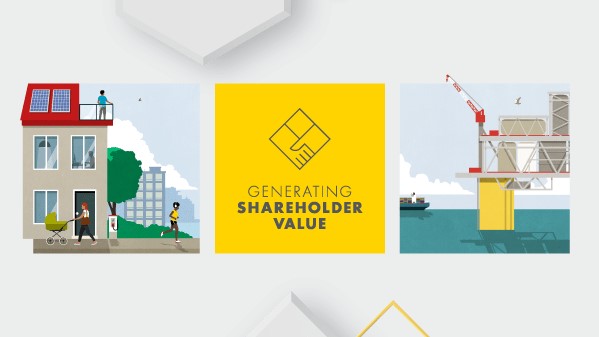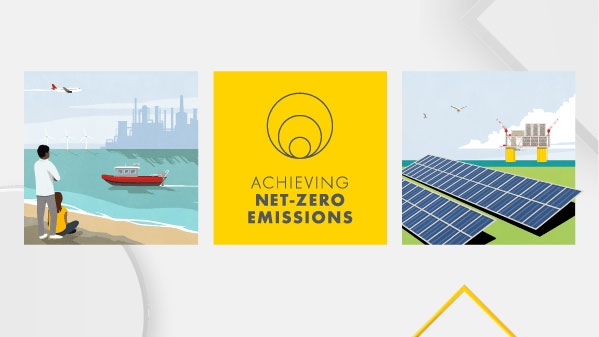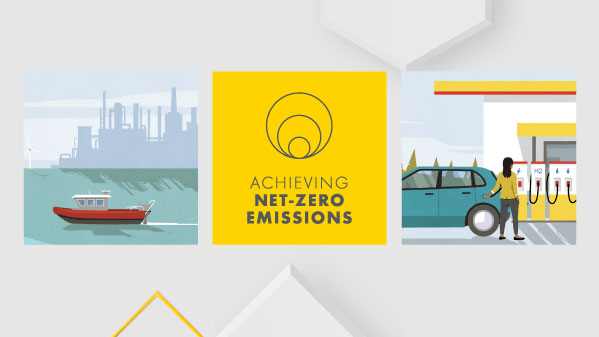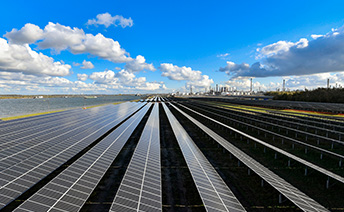Hydrogen Europe
Hydrogen Europe represents the interests of the hydrogen industry and its stakeholders, encompassing the entire value chain of the European hydrogen and fuel cell ecosystem. It has more than 400 members, including 25 EU regions and 30 national associations.[1]
Membership of board/executive committee: None
- 2022 assessment outcome: Aligned
- 2021 assessment outcome: Aligned
Summary
Shell benefits from its membership of Hydrogen Europe, in particular from its advocacy of policy levers to establish an EU hydrogen economy. Hydrogen Europe is the only EU trade association representing the full hydrogen value chain.
We have found Hydrogen Europe to be aligned with our climate and energy transition-related policy positions.
We will remain a member of Hydrogen Europe. We will continue to engage the association on climate and energy transition topics. We will continue to track alignment between Hydrogen Europe’s climate and energy transition-related positions and our own.
Further information
Click on the sections below to read more.
Paris Agreement and net-zero emissions
- Hydrogen Europe has stated support for the climate targets of the Paris Agreement and the EU’s 2050 climate neutrality target.[2] [3] [4]
- Hydrogen Europe’s Charter requires that its members support the European Green Deal, the climate targets of the Paris Agreement, and the European Climate Law.[5]
- In its 2022 position paper on REPowerEU, Hydrogen Europe states support for the REPowerEU package and sets out a list of key recommendations for policymakers which include increasing the 2030 renewable energy target to 45%, keeping the ambition of the 50% renewable fuels of non-biological origin binding target in industry by 2030, and defining low-carbon hydrogen by 2023.[6]
Carbon pricing
- Hydrogen Europe has stated support for carbon pricing policy.[7] In its 2022 position paper “ETS and CBAM – implications for the hydrogen sector”, Hydrogen Europe stated “the deep decarbonisation of the EU economy and developing a clean hydrogen market requires a wide range of enabling conditions and measures, including a robust carbon pricing policy. The EU Emission Trading System (ETS) should provide a reliable price for CO2 emissions and ensure the necessary flexibility, predictability, and competitiveness for operators and whole value chains.”[8]
- In a 2022 statement relating to the Fit for 55 Package, Hydrogen Europe advocates for a greater sectoral coverage under the ETS, inclusion of all hydrogen types in the ETS, zero-rating of renewable fuels of non-biological origins targets (RFNBOs) under the ETS, and introduction of a carbon border adjustment mechanism (CBAM).[9]
Energy efficiency
- In 2021 and 2022 recommendations relating to the amendment of the EU Energy Efficiency Directive, Hydrogen Europe called for the promotion of the principle of ‘energy system efficiency’ alongside the ‘energy efficiency first’ principle in the Energy Efficiency Directive.[10] [11]
Decarbonised hydrogen
- Hydrogen Europe’s charter requires its members to: “Recognise hydrogen as a net zero emission society enabler” and “Respect that hydrogen can be produced in many ways and support the acceleration of all zero-emission technologies with a priority on renewably produced hydrogen.”[12]
- Hydrogen Europe states that it is “imperative” for the EU to set clean hydrogen targets to ensure that investments are directed towards hydrogen to help meet the 2030 climate targets.[13]
- In Hydrogen Europe’s 2022 position paper “A regulatory framework fit for a European hydrogen market”, Hydrogen Europe states that it “welcomes the European efforts to move hydrogen legislation from an afterthought to a central pillar of the energy system” and stated a number of policy recommendations for developing a regulatory framework fit for a European hydrogen market.[14]
- In Hydrogen Europe’s 2022 position paper “ETS and CBAM – implications for the hydrogen sector”, Hydrogen Europe has recommended that EU ETS “benchmarks should be adapted to reward clean hydrogen production and consumption.”[15]
Natural ecosystems
No position
Carbon capture and storage
- Hydrogen Europe was one of the signatories of a joint statement in 2022 on a ‘Pragmatic regulatory framework necessary for hydrogen market’, which stated that achieving the EU’s ambitions would “require a safe investment environment and sufficient planning certainty for the rapid scale-up of renewable fuels of non-biological origin, hydrogen derivatives such as synthetic fuels, and underlying technologies such as Carbon Capture and Utilisation (CCU).”[16] [17]
- In 2021 Hydrogen Europe made recommendations for Europe’s hydrogen strategy, including: “A clear, predictable and non-discriminatory policy framework that enables and supports the roll out of activities/investments for power-to-gas as well as conversion facilities for hydrogen from natural gas in combination with CCS.”[18]
Environmental, social and governance (ESG) standards and benchmarks, sustainable finance taxonomies
No position
Coal
No position
Electrification with renewable or low-carbon power
No position
Gases and methane
No position
Road transport: Passenger cars and vans
- Hydrogen Europe supports the use of hydrogen “to decarbonise all mobility applications”.[19]
- In 2021 Hydrogen Europe stated support for the EU’s proposal for CO2 emissions standards for cars and vans, however it recommended a different methodological approach to measuring emissions, and called for “greater clarity on the accounting for internal combustion technologies that produce minimal CO2 emissions per kilometre, such as hydrogen-fuelled internal combustion engines”.[20]
- Hydrogen Europe signed a 2022 joint industry letter calling on “Member States and Members of European Parliament to set ambitious and timely targets for the deployment of alternative fuels infrastructure in the European Union”.[21]
Road transport: Heavy-duty vehicles
No position
Heavy industry decarbonisation
- In a 2022 Hydrogen Europe position paper on REPowerEU, Hydrogen Europe recommended that policymakers should keep the ambition of the 50% renewable fuels of non-biological origins binding target in industry by 2030.[22]
Aviation
- Hydrogen Europe has stated support for the decarbonisation of aviation.[23] [24] Hydrogen Europe supports the use of sustainable aviation fuels as the most viable decarbonisation option in the short term, including through mandates for Renewable Fuels of Non-Biological Origin (RFNBOs) and sustainable aviation fuel (SAF).[25]
- In 2022 statements, Hydrogen Europe stated support for the European Parliament’s adoption of the report to increase the uptake of SAF, setting mandatory blending targets from 2025.[26] [27]
- Hydrogen Europe signed up to a 2022 joint letter that called for the inclusion of renewable hydrogen in the list of fuels covered by ReFuelEU Aviation.[28] [29]
Shipping
- Hydrogen Europe has stated support for the decarbonisation of shipping.[30] Hydrogen Europe has stated that hydrogen and hydrogen-based fuels and technologies offer “tremendous potential for the maritime sector” and can “significantly” contribute to decarbonisation.[31]
- Hydrogen Europe has stated: “The IMO discussions on the decarbonisation strategy are progressing but this must be accelerated in order to meet the European Green Deal objectives of carbon neutrality by 2050.”[32]
- In a 2022 Hydrogen Europe statement, Hydrogen Europe called for the inclusion of the maritime sector under the ETS I.[33]
- In a 2022 Hydrogen Europe post on FuelEU Maritime regulation, Hydrogen Europe advocated for 6% sub-quotas for renewable fuels of non-biological origin in maritime transport by 2030.[34]
- In 2022, Hydrogen Europe stated on social media that more ambitious greenhouse gas emissions reduction targets are needed in the FuelEU Maritime plan, especially for 2025 and 2030.[35]
[1] https://hydrogeneurope.eu/mission-vision/
[2] https://hydrogeneurope.eu/wp-content/uploads/2021/11/How-hydrogen-can-help-decarbonise-the-maritime-sector_final.pdf
[3] https://hydrogeneurope.eu/wp-content/uploads/2022/02/HE_Charter.pdf
[4] https://hydrogeneurope.eu/yes-to-45-res/
[5] https://hydrogeneurope.eu/wp-content/uploads/2022/02/HE_Charter.pdf
[6] https://hydrogeneurope.eu/wp-content/uploads/2022/05/2022.05.16_HE_PositionPaper_REPowerEU.pdf
[7] https://hydrogeneurope.eu/wp-content/uploads/2022/10/EU-ETS-and-CBAM-implications-for-the-hydrogen-sector_final.pdf
[8] https://hydrogeneurope.eu/wp-content/uploads/2022/10/EU-ETS-and-CBAM-implications-for-the-hydrogen-sector_final.pdf
[9] https://www.linkedin.com/posts/hydrogen-europe_hydrogen-europe-activity-6940682505909886976-1l1p/?utm_source=share&utm_medium=member_desktop
[10] https://hydrogeneurope.eu/wp-content/uploads/2021/11/Hydrogen-Europe-Position-Paper-on-the-Fit-for-55-Package.pdf
[11] https://hydrogeneurope.eu/wp-content/uploads/2022/03/HYDROG1.pdf
[12] https://hydrogeneurope.eu/wp-content/uploads/2022/02/HE_Charter.pdf
[13] https://hydrogeneurope.eu/policy-priorities/
[14] https://hydrogeneurope.eu/wp-content/uploads/2022/06/220609-A-regulatory-framework-fit-for-a-European-h2-market-Final-2.pdf
[15] https://hydrogeneurope.eu/wp-content/uploads/2022/10/EU-ETS-and-CBAM-implications-for-the-hydrogen-sector_final.pdf
[16] https://hydrogeneurope.eu/wp-content/uploads/2022/07/2022.07_Joint-Letter-by-18-Industry-Associations-on-REDII-DA.pdf
[17] https://www.linkedin.com/posts/hydrogen-europe_climatechange-renewablehydrogen-delegatedact-activity-6981250411739410433-Ha67/?utm_source=share&utm_medium=member_desktop
[18] https://hydrogeneurope.eu/wp-content/uploads/2021/11/The-EU-Hydrogen-Strategy_-Hydrogen-Europes-top-10-key-recommendations_FINAL.pdf
[19] https://hydrogeneurope.eu/policy-priorities/
[20] https://hydrogeneurope.eu/wp-content/uploads/2021/12/HydrogenEurope-CO2-emission-standards-for-LDVs-position-paper.pdf
[21] https://hydrogeneurope.eu/wp-content/uploads/2022/05/Joint-letter-on-alternative-fuels-infrastructure.pdf
[22] https://hydrogeneurope.eu/wp-content/uploads/2022/05/2022.05.16_HE_PositionPaper_REPowerEU.pdf
[23] https://hydrogeneurope.eu/wp-content/uploads/2021/12/HydrogenEurope-ReFuelEU-Aviation-position-paper.pdf
[24] https://hydrogeneurope.eu/wp-content/uploads/2021/12/Hydrogen-Europe-Position-Paper-on-carbon-markets_Final.pdf
[25] https://hydrogeneurope.eu/wp-content/uploads/2021/12/HydrogenEurope-ReFuelEU-Aviation-position-paper.pdf
[26] https://hydrogeneurope.eu/ep-adopts-refueleu-report/
[27] https://www.linkedin.com/posts/hydrogen-europe_hydrogen-europe-activity-6952904868281909248-EU-O/?utm_source=share&utm_medium=member_desktop
[28] https://www.linkedin.com/posts/hydrogen-europe_refueleu-aviation-open-letter-asd-he-and-activity-6937013086247645185-Zclv/?utm_source=share&utm_medium=member_desktop
[29] https://hydrogeneurope.eu/wp-content/uploads/2022/05/2022.05_HE_ReFuelEU_Aviation_Letter-final.pdf
[30] https://www.hydrogeneurope.eu/wp-content/uploads/2021/11/How-hydrogen-can-help-decarbonise-the-maritime-sector_final.pdf
[31] https://www.hydrogeneurope.eu/wp-content/uploads/2021/11/How-hydrogen-can-help-decarbonise-the-maritime-sector_final.pdf
[32] https://www.hydrogeneurope.eu/wp-content/uploads/2021/11/How-hydrogen-can-help-decarbonise-the-maritime-sector_final.pdf
[33] https://www.linkedin.com/posts/hydrogen-europe_hydrogen-europe-activity-6940682505909886976-1l1p/?utm_source=share&utm_medium=member_desktop
[34] https://www.linkedin.com/posts/hydrogen-europe_fueleumaritime-hydrogen-decarbonisation-activity-6987699616230076416-kA5s/?utm_source=share&utm_medium=member_desktop
[35] https://twitter.com/H2Europe/status/1582029961866915841










